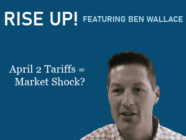Last week was the worst for stocks since the dark days of the pandemic onset in March 2020. As perhaps every adult human on the planet knows by now, on April 2 the Trump administration introduced a systematic tariff program that was deeper and more severe than anticipated. China retaliated with elevated tariffs, and time will tell if there will be others. Before last week’s 10% drubbing, stocks were already in a precarious position, entering the week at -5% for the year. Two consecutive years of 20% plus returns for the S&P 500 meant that a lot of optimism had already been built into stock prices, leaving both little room for disappointment and stocks ripe for a period of consolidation with high valuations relative to bonds (earnings yield vs 10-Year Treasury yield) and foreign stock markets. Now much of that exuberance has washed out of stock prices very quickly.
Tariffs are a tax on goods imported to a country from another. The result is tax revenue, but also usually higher prices on those imported goods. Sometimes these higher prices protect domestic producers of that same product, so that they can charge more and still be competitive. Many nations have had tariffs and other trade restrictions on the United States for decades, making it more difficult for U.S. companies to compete overseas. The U.S. is the largest consumer nation in the world, and the largest trading partner to many, if not most, other countries. Levying hefty tariffs is the stick that President Trump is wielding in an effort to force other nations to adopt friendlier trade practices, along with other demands.
History is written in hindsight, not in real time. If this strategy is effective, then Trump could go down as one of the most successful presidents in the modern era. But if this aggressive move fails and results in economic calamity, then he could be remembered as a modern-day villain and complete failure. It is a big gamble. If trade, government inefficiency and wasted national spending were easy to fix, then it would have been done already.
Two Potential Scenarios
The positive scenario from here would be that other nations begin to negotiate in earnest, and the regulations change. These tariffs are formulaic, and nations understand exactly what needs to happen if they want the tariffs to change. Progress toward negotiation with Europe could bring a very positive reaction from stocks. There is also the possibility that the tariffs simply do not have as much of an economic impact as many fear.
On the negative side, tariffs could significantly strain the economy. The lesser tariffs of Trump’s first administration did not produce much inflation (increase in price levels), but that is largely due to “friendshoring” or switching trade partners for goods. This time there do not appear to be many (or any) friends, and inflation could be more of a problem. If this is the case, then the Fed will be less able to lower rates should the economy weaken. The uncertainty with the radical policy change could cause companies to stop spending and investing for fear of being on the wrong side of another policy shift. Consumers may spend less due to higher prices and fear of a falling stock market impacting their net worth. The result could be recession. Indeed, the odds of recession have increased, and JP Morgan put the odds of recession at 60% on Friday (for whatever that is worth).
While markets can certainly overreact in the short run, there is a reason they reacted strongly to this announcement: The tariff methodology, resulting in much higher than expected tariff rates, as well as some unexpected targets, makes it more damaging to companies with global supply chains. The risk is the policy compromises business and national relationships that have been built over decades with our better trading partners, while not encouraging the true bad trading partners to get better. The positive is that they were deliberately set to be high, which could act as a point of leverage to start reduction talks more quickly. The tariff threat can exit the market as quickly as it arrived.
How We Are Responding
Be careful of what you hear from the talking heads on television. Nobody understands what will happen going forward because it is completely unknowable. Supply chains are incredibly complex, and they can change, sometimes more quickly than thought, other times with far more difficulty. Think of what occurred during the pandemic: Nobody got that call right, expecting two months of pain and then one of the biggest, fastest market rallies of all time – not that I am predicting a large market rally because after all, we do not predict anything. We are in the business of measuring and reacting to what is happening in real time as reflected in stock prices.
What that means for our clients is that in every tactical stock strategy that we manage, we entered the week with 25% to 50% of those portfolios allocated out of stocks and into cash / money markets based on signals that had already occurred. In our flagship Risk Managed Income strategy, we raised cash for about half of the portfolio last week. This is the first defensive trade in over two years. It has been a great run (the longest since inception in 2011), but it is now time to start playing defense to see what happens next. We stand ready to move even more defensively, but we are also ready to reinvest that dry powder. It is up to the market to give us some direction from here. Additionally, high-quality fixed income and alternative investments have done a nice job countering the volatility from the stock side. It is these difficult periods when the time-tested concept of traditional diversification pays off.
For all investors, a minus 10% week is severe by any measure, and certainly scary. Markets can do crazy things in the short run and are prone to overreact during periods of rapid shifts in information. Investing is for the long run. Winning is reaching financial goals. The enemy is overreacting. Selling without a plan is just as bad as buying because everyone else is, and both put reaching financial goals in jeopardy. It is our job to worry about client portfolios, so they do not have to, and make investment decisions during the difficult times to keep our investors on their path to success.
Important Disclosures:
Please remember that past performance is no guarantee of future results. Different types of investments involve varying degrees of risk, and there can be no assurance that the future performance of any specific investment, investment strategy, or product (including the investments and/or investment strategies recommended or undertaken by Grimes & Company, LLC [“Grimes”]), or any non-investment related content, made reference to directly or indirectly in this blog will be profitable, equal any corresponding indicated historical performance level(s), be suitable for your portfolio or individual situation, or prove successful. Due to various factors, including changing market conditions and/or applicable laws, the content may no longer be reflective of current opinions or positions. Moreover, you should not assume that any discussion or information contained in this blog serves as the receipt of, or as a substitute for, personalized investment advice from Grimes. To the extent that a reader has any questions regarding the applicability of any specific issue discussed above to his/her individual situation, he/she is encouraged to consult with the professional advisor of his/her choosing. No amount of prior experience or success should be construed that a certain level of results or satisfaction will be achieved if Grimes is engaged, or continues to be engaged, to provide investment advisory services. Grimes is neither a law firm nor a certified public accounting firm and no portion of the blog content should be construed as legal or accounting advice. A copy of the Grimes’ current written disclosure Brochure discussing our advisory services and fees is available for review upon request or at https://www.grimesco.com/form-crs-adv/. Please Note: Grimes does not make any representations or warranties as to the accuracy, timeliness, suitability, completeness, or relevance of any information prepared by any unaffiliated third party, whether linked to Grimes’ web site or blog or incorporated herein, and takes no responsibility for any such content. All such information is provided solely for convenience purposes only and all users thereof should be guided accordingly. Please Remember: If you are a Grimes client, please contact Grimes, in writing, if there are any changes in your personal/financial situation or investment objectives for the purpose of reviewing/evaluating/revising our previous recommendations and/or services, or if you would like to impose, add, or to modify any reasonable restrictions to our investment advisory services. Unless, and until, you notify us, in writing, to the contrary, we shall continue to provide services as we do currently. Please Also Remember to advise us if you have not been receiving account statements (at least quarterly) from the account custodian.



